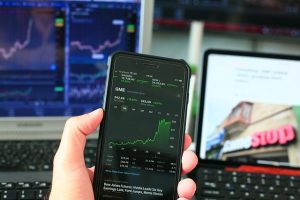11 Financial Technology (FinTech) in Banking and Investing*
Learning Objectives:
- Identify benefits and drawbacks of financial technologies used by consumers and financial services companies.
- Understand automated transactions.
- Be able to assess fintech apps and services before signing up.
What is Financial Technology (FinTech)?
If you’ve ever ‘Venmoed’ money to a friend to split the restaurant check or deposited a check online, you’ve used fintech or financial technology!
FinTech (financial technology) refers to new technologies created to improve and automate traditional delivery and use of financial services for businesses and consumers. FinTech can include everything from simple mobile payment apps to complex blockchain networks of cryptocurrency transactions (Kagan, 2024) (for more on cryptocurrency, see also Alternative Investments chapter).
Fintech has the potential to democratize financial services and promote inclusion with products and services that are easier for consumers to access and use. It leverages technology to:
- speed processes;
- improve convenience; and
- lower costs.
Often seen as a disrupter to more traditional banking and brokerage services, fintech uses software, apps, and algorithms to help consumers, small businesses, and large companies manage their finances. More recently, however, established banks and finance companies have introduced their own fintech, which dilutes the image of fintech as challenging Wall Street’s more established financial firms. For example, after the mobile stock-trading app Robinhood offered commission-free online trading, a number of traditional investment brokerage firms, such as E*Trade and Charles Schwab, followed suit.
Fintech includes a broad array of companies and technologies, including:
- Alternatives to traditional banking and financial services firms;
- Additional financial services for consumers; and
- Support services for traditional financial firms. (Han, n.d.)
The Technology
A sample of the technologies being used in fintech products and services includes:
 Chatbots
Chatbots
In fintech, chatbots are often used by financial service companies to handle basic customer service interactions.
 Internet of Things (IOT)
Internet of Things (IOT)
Among fintech resources, you can see the Internet of Things at work in contactless payments, whereby sensors enable payment for goods and services by wave of a credit/debit card, smartphone with enabled payment app, or digital wallet above a store’s payment reader.
 Virtual & Augmented Reality
Virtual & Augmented Reality
An example of virtual reality in fintech comes from banks using it to train employees to handle the more difficult customer service conversations. Augmented reality can be used by customers to find nearby banks and ATMs by checking the area with their phones.
 Artificial Intelligence (AI) & Machine Learning
Artificial Intelligence (AI) & Machine Learning
AI powers robo-advisors, automated digital platforms that use algorithms to provide investment and financial planning advice with little-to-no human intervention.
 Biometrics
Biometrics
In fintech, biometrics can provide added security when a person has to use a fingerprint to unlock their cellphone in order to access an investing app.
(image from SMEX CC BY-SA 4.0)
 Cloud Computing
Cloud Computing
Fintech apps based on cloud computing allow users to manage their money and accounts remotely. (Gensler, 2020)
Products and Services
A sample of some of the more popular fintech products and services includes:
Apps
Many fintech products and services, often available through apps, are finding underserved niches in the present financial system, such as the unbanked (people who don’t have a bank account), low- and middle-income customers, and younger people just beginning their financial journeys. Apps often support consumers in the important areas of saving and budgeting in ways that regular banks don’t. And apps can more easily specialize in a particular service for people who don’t need the wide range of offerings of brick-and-mortar banks or the fees that come with those buildings and products. Finally, fintech apps are known for engaging users with slick design and fun elements to help users reach their goals.
Is a “neobank” not really a bank?
Neobanks—like Chime or Varo—are mobile-focused financial institutions. They often offer fewer services than traditional banks in order to keep costs down. Some neobanks, such as Varo, are chartered as banks and can provide Federal Deposit Insurance Corporation (FDIC) deposit insurance themselves. Those that are not, such as Chime, serve only as an interface or intermediary and partner with traditional banks that hold customers’ money and provide the FDIC deposit insurance. (Walden, 2021)
This distinction does not usually affect consumers as long as deposits are insured and the fintech’s financial operations run smoothly. However, when there are problems with fintech, people can lose their money, as may be happening with the April 2024 bankruptcy of Synapse, a company that “essentially acted as a bookkeeper” between fintech app companies and the actual banks they partnered with. However, the fintech companies were not banks and, therefore, money in them could not be insured by the FDIC. In the case of Synapse, the company did not keep accurate records of money going in and out of customer accounts for apps such as Yotta, Juno, and Yieldstreet. As a result, tens of thousands of customers were unable to access their funds: Synapse had no record of the deposits and the money had never gone on to the partner banks. As of December 2024, investigators were still trying to piece together what happened and where depositors’ money had gone. (Vansomeren, 2024)
Automated Money Transfers to Your Savings Account
People who save successfully generally choose an automatic system of saving for their goals. They make the decision about where to save, set up the system, and then save money from every paycheck without having to think about it. If you have a bank account and direct deposit, you can arrange to automatically deposit some of your paycheck into a savings account every time you are paid.
With direct deposit or electronic fund transfers (EFTs), the general public, government agencies, businesses, and other institutions can pay and collect money electronically, without having to use paper checks. Direct deposit and other EFTs are “safe, secure, efficient, and less expensive” than paper check payments and collections (U.S. Bureau of the Fiscal Service, 2024). The Electronic Fund Transfer Act (EFTA) of 1978 was enacted to protect individual consumers engaging in EFTs and remittance transfers. Financial institutions use the Automated Clearing House (ACH) to process electronic fund transfers (U.S. Bureau of the Fiscal Service, 2022).
When automating your saving, keep in mind your SMART savings goals from the Why Budget? Budgeting as Spending Plan chapter. Your bank may let you set up different funds or “buckets” within your savings account that you can use to save for separate goals, for example, travel or an emergency fund. Learn more about the benefits and how to use EFTs to automate your saving whether you use an online only or a traditional bank. (Sherman, 2023)
Investing with Robo-advisors
Watch this video to learn about these automated platforms consumers can use in investing:
AI and Your Finances
Personal finance tools that use artificial intelligence (AI) can provide personalized recommendations and insights for financial planning at the click of a button, for example, allowing people to interact with a chatbot about how to save more money. Receiving tailored financial advice from an app on the phone is more affordable than hiring a person to do financial planning. And AI-enhanced apps appeal to many users who appreciate their abilities to simplify complex financial topics, track expenses, or show the state of their financial accounts all together in one place. Easier access to personal finance information can better support individuals as they make decisions on their financial journey. (Sircar, 2024)
On the other hand, generative AI tools such as ChatGPT and Google’s Gemini often depend on publicly available data that may be generic, inaccurate, or incomplete. AI tools can sometimes simplify financial decisions too much, leaving out important contextual or other complex information. Simplifying just for the sake of ease might lead to worse financial outcomes rather than improved outcomes. Also, problems may occur if a user asks a poorly-worded question to an AI tool and receives bad advice for their situation. But AI continues to evolve rapidly, and apps that train their AI on money topics specifically usually give better financial guidance than general use tools that don’t. (Sircar, 2024)
Most financial experts feel that generative AI shows more promise when used as an assistant rather than a substitute for humans who have personal knowledge of an individual’s situation and goals as well as specialized knowledge of financial markets, products, and services. (Sircar, 2024)
Fintech Challenges

Where fintech companies have run into difficulty is that their strength—leveraging technology to reach more people and keep costs low—can also be a weakness.
- People who are digitally excluded by not having easy access to wifi, such as some low-income and rural consumers, may not be able to use fintech reliably.
- Customer service may be more difficult for consumers if they can’t call or visit a branch office to talk to a person. For example, Cash App’s parent company was fined for failing to investigate complaints of unauthorized transactions in customer accounts and making it difficult for users to get help from the company (Consumer Finance Protection Bureau [CFPB], 2025).
- Fintech companies can be challenged by unexpected growth and activity; an example is the problems experienced by the banking app Chime with the influx of federal stimulus payments during the pandemic.
- Data security and privacy become even more important so that customers’ sensitive financial information and banking account logins are not exposed through cyberattacks (Consumer Action, 2021). The Cash App fraud mentioned above resulted from weak security on the part of the app (CFPB, 2025). Learn more about keeping your personal financial data private and secure from unauthorized access.
- Some of the investing fintechs have been criticized for their game-like elements, which may encourage some users to make inappropriate investments as they get caught up in the game (Zoican, 2024).
How to Choose
Deciding whether to dive in and use a fintech app or service—or choosing which one, if you’ve made the decision to take the plunge—depends on your financial goals and needs. Do you want to save more money? Do you need help tracking spending across multiple credit and debit accounts? Do you want to dip a toe into the investing waters? Consider these questions as well as those below as you consider which app to use.
- Is there a minimum account balance you must maintain to use the service?
- How will the app connect to your financial accounts? Does it work with any financial institution’s accounts?
- How does it secure your personal information?
- Is the service platform mobile-only or can you use it through a website on a computer if your phone is lost or doesn’t work?
- What fees does it charge and under what conditions? An app may advertise overdraws with no penalty, but there may be a limit to the number of times or amount that you can overdraw without paying a fee.
- What options exist to get help when there’s a problem? Is there a phone number you can call with a person on the other end, or are you limited to tweeting the help desk?
- How does the company behind the app make money from this? Is it selling your personal information?
Seek out reviews from actual users to see what their experiences—both good and bad—have been and if those experiences will be relevant to how you’ll use the app or service. Do your research and treat your hard-earned money with the care it deserves.
Get a start on finding some of the better budgeting apps from these websites:
Activity
Read pages 1-11 of the report Gen Z and Investing: Social Media, Crypto, FOMO, and Family, issued by the Financial Industry Regulatory Authority [FINRA] Investor Education Foundation and the Chartered Financial Analyst [CFA] Institute (FINRA & CFA, 2023). If you’re interested in data from China, the UK, or Canada, you can read any of those sections as well (pages 11-15). Focus on data about your own generation as defined on page 1. Discuss or write a reflection: Which data surprised you the most? Why? What data do you think shows your generation is on the right track financially? Is there any data you saw that may indicate a problem for your generation reaching its financial goals?
Key Takeaways:
- The Electronic Fund Transfer Act of 1978 is intended to protect individual consumers engaging in electronic fund transfers (EFTs) and remittance transfers.
- Fintech can provide easier and lower cost ways for people to manage their money; however, customer service and data security remain weaknesses in the system.
- Carefully evaluate any personal finance app before signing up and giving that app company access to your personal finance information.
*Combined and adapted from What’s up with fintech? by E. Jardine (CC BY-NC-SA 4.0) and Class 1: Intro and Key Technological Trends Affecting Financial Services of MIT 15.S08 S20 FinTech: Shaping the financial world by Gary Gensler (CC BY-NC-SA 4.0), unless otherwise indicated.
Test Your Knowledge
Please Provide Feedback
What is one tip that you learned from this chapter?
References
Consumer Action. (2021). Privacy and security when using fintech apps. https://www.consumer-action.org/downloads/english/FinTech_privacy_tips_2021_EN_v1.1.pdf
Consumer Finance Protection Bureau. (2025, January 16). CFPB orders operator of Cash App to pay $175 million and fix its failures on fraud. https://www.consumerfinance.gov/about-us/newsroom/cfpb-orders-operator-of-cash-app-to-pay-175-million-and-fix-its-failures-on-fraud/
FINRA Investor Education Foundation, & CFA Institute. (2023, May). Gen Z and investing: Social media, crypto, FOMO, and family. https://www.cfainstitute.org/-/media/documents/article/industry-research/Gen_Z_and_Investing.pdf
Han, M. (n.d.). Introduction to fintech [PowerPoint slides]. Kennesaw State University, College of Computing and Software Engineering. https://ksuweb.kennesaw.edu/~mhan9/ALG/it4603/Class%200.pptx
Kagan, J. (2024, March 25). Financial technology (fintech): Its uses and impact on our lives. Investopedia. https://www.investopedia.com/terms/f/fintech.asp
Sherman, E. (2023 May 17). How to automate your savings – and why it’s a good idea. U.S. News & World Report. https://money.usnews.com/money/personal-finance/family-finance/articles/how-to-automate-your-savings
Sircar, A. (2024, December 11). Are generative AI tools in personal finance game-changers or risky bets? Forbes. https://www.forbes.com/sites/anishasircar/2024/12/06/generative-ai-tools-in-personal-finance-game-changers-or-risky-bets/
U.S. Bureau of the Fiscal Service. (2022, December 23). Automated Clearing House [ACH]. https://www.fiscal.treasury.gov/ach/
U.S. Bureau of the Fiscal Service. (2024, February 21). Direct deposit (Electronic Funds Transfer). https://www.fiscal.treasury.gov/eft/
Vansomeren, L. (2024, December 9). Think fintech is safe? This hidden danger could cost you. Investopedia. https://www.investopedia.com/think-fintech-is-safe-this-hidden-danger-could-cost-you-8758561
Walden, S. (2021, June 24). What is a neobank? Forbes Advisor. https://www.forbes.com/advisor/ banking/what-is-a-neobank/
Zoican, M. (2024, November 24). Gamified investing apps are becoming more popular — but can be risky for young investors. The Conversation. https://theconversation.com/gamified-investing-apps-are-becoming-more-popular-but-can-be-risky-for-young-investors-243442
